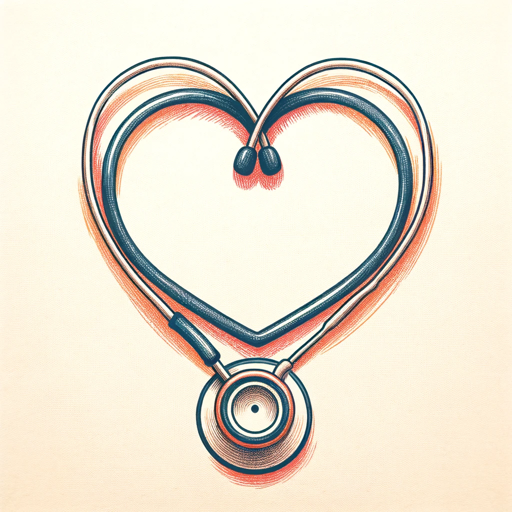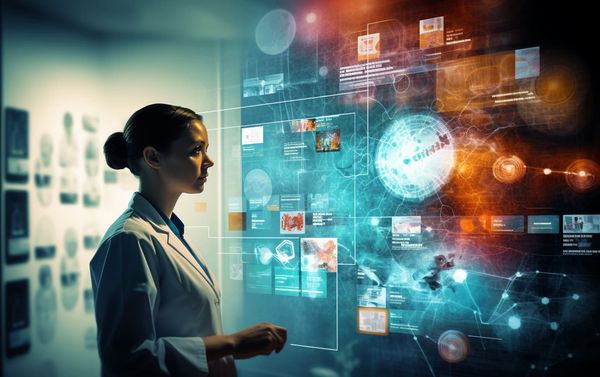The Face-Off: ChatGPT-4 vs. Human Physicians
In a new study conducted by Beth Israel Deaconess Medical Center (BIDMC), the artificial intelligence program ChatGPT-4 went head-to-head with internal medicine residents and attending physicians in processing medical data and demonstrating clinical reasoning. The results, published in JAMA Internal Medicine, shed light on the potential of AI in healthcare and its current limitations.
Deconstructing Clinical Reasoning with r-IDEA Scores
To evaluate the clinical reasoning abilities of both AI and human physicians, the researchers employed the revised-IDEA (r-IDEA) score, a validated tool designed to assess physicians' diagnostic thought processes. The study involved 21 attending physicians and 18 residents, each tackling one of 20 selected clinical cases across four sequential stages of diagnostic reasoning. ChatGPT-4 was given identical prompts and ran all 20 cases.
Breakdown of the study conducted by Beth Israel Deaconess Medical Center (BIDMC) physician-scientists:
- Participants:
- 21 attending physicians
- 18 residents
- ChatGPT-4, an artificial intelligence program
- Study Design:
- Participants worked through one of 20 selected clinical cases, each comprising four sequential stages of diagnostic reasoning.
- Physicians were instructed to write out and justify their differential diagnoses at each stage.
- ChatGPT-4 was given a prompt with identical instructions and ran all 20 clinical cases.
- Evaluation Tool:
- The study used the revised-IDEA (r-IDEA) score, a previously validated tool developed to assess physicians' clinical reasoning.
- Answers were scored for clinical reasoning (r-IDEA score) and several other measures of reasoning.
- Results:
a. r-IDEA Scores:b. Diagnostic Accuracy and Correct Clinical Reasoning:c. Instances of Incorrect Reasoning:- ChatGPT-4 earned the highest r-IDEA scores, with a median score of 10 out of 10.
- Attending physicians had a median score of 9.
- Residents had a median score of 8.
- The performance of humans and ChatGPT-4 was more evenly matched in terms of diagnostic accuracy (the correct diagnosis's position on the provided list) and correct clinical reasoning.
- ChatGPT-4 was "just plain wrong" significantly more often than residents, having more instances of incorrect reasoning in their answers.
- Four Sequential Stages of Diagnostic Reasoning:
- Stage 1: Triage data (patient's main concern and vital signs)
- Stage 2: System review (obtaining additional information from the patient)
- Stage 3: Physical exam
Results: AI's Edge in Diagnostic Reasoning and Accuracy
The results were surprising: ChatGPT-4 outperformed both residents and attending physicians in clinical reasoning, earning the highest median r-IDEA score of 10 out of 10, compared to 9 for attending physicians and 8 for residents. When it came to diagnostic accuracy – the correct diagnosis's position on the provided list – AI and human physicians were more evenly matched.
- r-IDEA Scores:These scores indicate that ChatGPT-4 outperformed both attending physicians and residents in terms of clinical reasoning, as assessed by the revised-IDEA (r-IDEA) score. The AI program's ability to process medical data and demonstrate clinical reasoning surpassed that of the human participants in this study.
- ChatGPT-4: median score of 10 out of 10
- Attending physicians: median score of 9
- Residents: median score of 8
- Diagnostic Accuracy and Correct Clinical Reasoning:This finding suggests that while ChatGPT-4 excelled in overall clinical reasoning, as measured by the r-IDEA score, its ability to accurately diagnose and provide correct clinical reasoning was comparable to that of human physicians. This implies that AI's strengths lie in its ability to process and analyze large amounts of data quickly, but it may not necessarily outperform humans in terms of the accuracy of the final diagnosis.
- The performance of humans and ChatGPT-4 was more evenly matched in terms of diagnostic accuracy (the correct diagnosis's position on the provided list) and correct clinical reasoning.
- Instances of Incorrect Reasoning:Despite ChatGPT-4's high r-IDEA scores, the AI program made more errors in reasoning compared to human residents. This finding highlights a critical limitation of AI in healthcare: while it can process and analyze data efficiently, it is still prone to making mistakes that humans might avoid. This underscores the importance of using AI as a tool to support and augment human decision-making rather than relying on it as a standalone solution.
The study's results demonstrate that AI programs like ChatGPT-4 have the potential to significantly enhance clinical reasoning processes, given their ability to quickly analyze vast amounts of medical data. However, the higher instances of incorrect reasoning compared to human residents emphasize the need for caution and further research when integrating AI into clinical practice.
The Achilles' Heel: When AI Gets It Wrong
Despite ChatGPT-4's impressive performance, the study revealed a significant weakness: the AI program was "just plain wrong" more often than the human residents. This finding underscores the notion that AI, in its current state, is not a replacement for human reasoning but rather a potential tool to augment the diagnostic process.
Envisioning AI as a Collaborative Tool in Healthcare
Lead author Stephanie Cabral, MD, a third-year internal medicine resident at BIDMC, sees AI as a potential checkpoint in the diagnostic process, helping physicians avoid overlooking critical information. Rather than replacing human judgment, AI could help streamline inefficiencies and allow physicians to focus more on patient interactions. As co-author Adam Rodman, MD, notes, this study demonstrates AI's capacity for real reasoning, presenting a unique opportunity to enhance healthcare quality and patient experience.
He also states that "Further studies are needed to determine how LLMs can best be integrated into clinical practice, but even now, they could be useful as a checkpoint, helping us make sure we don't miss something."
While further studies are needed to determine how AI can be effectively integrated into clinical practice, this research marks a significant step forward in understanding the potential of artificial intelligence in healthcare. As we navigate this new frontier, it is crucial to recognize AI's strengths and limitations, harnessing its power to support, rather than replace, the invaluable human element in medicine.
The study suggests that AI can be a valuable tool to support and augment human decision-making in healthcare, but it should not be viewed as a replacement for human expertise. The ideal approach would be to harness the strengths of both AI and human physicians, using AI to streamline data analysis and assist in the diagnostic process while relying on human judgment to ensure accuracy and mitigate potential errors in reasoning.
Opinions on the Study
A Closer Look at ChatGPTs Reasoning Shortcomings
I'll say this with no disrespect to the researchers, it's possible that the errors in ChatGPT-4's reasoning could be attributed to suboptimal prompting strategies. The researchers provided the AI with a prompt containing identical instructions to those given to the human participants.
Option 1. A Tailored Prompt
However, the prompt may not have been tailored to optimize the AI's reasoning process.
Here are a few ways in which poor prompt engineering could have contributed to ChatGPT-4's errors in reasoning:
- Lack of specificity: If the prompt was too broad or lacked specific guidance on how to approach the clinical reasoning task, the AI might have generated responses that, while leading to the correct diagnosis, followed a reasoning path that was not entirely accurate or appropriate.
- Insufficient Persona, Role & context: The prompt may not have provided enough contextual information about the clinical cases, leading the AI to make assumptions or rely on its general knowledge base, which could have introduced errors in reasoning.
- Ambiguity: If the prompt contained ambiguous instructions or lacked clarity in terms of the expected output format, the AI might have struggled to generate a response that accurately captured the reasoning process.
- Lack of domain-specific guidance: The prompt may not have included sufficient guidance on how to apply clinical reasoning principles or best practices specific to the medical domain, leading to errors in the AI's reasoning process.
To address these issues, researchers could explore more sophisticated prompt engineering techniques to optimize ChatGPT-4's performance in clinical reasoning tasks. This might involve:
- Iterative refinement: Researchers could engage in an iterative process of prompt design, testing, and refinement based on the AI's outputs to identify and address weaknesses in the prompting strategy.
- Domain-specific personas and prompts: Developing prompts that incorporate medical domain knowledge and clinical reasoning best practices could help guide the AI towards more accurate and appropriate reasoning paths.
- Structured output formats: Providing clear guidelines on the expected output format, such as step-by-step reasoning or specific sections for differential diagnoses, could help the AI generate more coherent and accurate responses.


By refining prompt engineering techniques and prompting strategies, I believe researchers may be able to improve ChatGPT-4's reasoning accuracy while maintaining its high diagnostic performance. This highlights the importance of carefully designing and optimizing the interaction between AI models and the prompts used to guide their outputs, particularly in complex domains such as healthcare.
Option 2: Generative AI Networks
The use of Generative AI Networks (GAINs) and the collaboration of multiple AI agents could indeed provide a potential solution to the reasoning issues encountered in the study involving ChatGPT-4. Let's explore how GAINs could be applied to improve the AI's clinical reasoning performance.


- Specialized AI Agents: In a GAIN system, each AI agent could be designed to focus on specific aspects of the clinical reasoning process. For example, one agent could specialize in gathering and analyzing patient data, another in generating differential diagnoses, and yet another in evaluating the reasoning behind each diagnosis. This specialization allows each agent to excel in its designated task, contributing to a more comprehensive and accurate reasoning process.
- Collaborative Decision-Making: By working together, the AI agents in a GAIN system can engage in collaborative decision-making. They can share their findings, compare their reasoning, and collectively arrive at the most plausible diagnosis. This collaborative approach can help mitigate the errors in reasoning that a single AI agent, like ChatGPT-4, might make. The collective intelligence of the GAIN system can lead to more robust and accurate clinical reasoning.
- Cross-Validation and Error Correction: In a GAIN system, the AI agents can cross-validate each other's reasoning and identify potential errors. If one agent's reasoning appears flawed or inconsistent, the other agents can flag it and initiate a process of error correction. This self-monitoring and self-correcting mechanism can help improve the overall accuracy of the AI's reasoning.
- Adaptive Learning: GAINs can leverage the power of adaptive learning to continuously improve their clinical reasoning capabilities. As the AI agents encounter more clinical cases and receive feedback from human experts, they can learn from their mistakes and refine their reasoning processes. This iterative learning approach can help the GAIN system become increasingly accurate and reliable over time.
- Integration with Human Expertise: While GAINs can significantly enhance the AI's clinical reasoning capabilities, it is essential to integrate them with human expertise. Human physicians can provide valuable insights, context, and domain knowledge that can guide the AI agents in their reasoning process. A collaborative approach between GAINs and human experts can lead to a more comprehensive and accurate clinical reasoning system.
- Transparency and Explainability: One of the challenges with AI systems, including ChatGPT-4, is the lack of transparency in their reasoning process. GAINs can be designed to provide more transparency and explainability in their decision-making. Each AI agent can generate explanations for its reasoning, allowing human experts to understand and validate the AI's thought process. This transparency can help build trust in the AI system and facilitate effective human-AI collaboration.
The use of Generative AI Networks and the collaboration of multiple AI agents present a promising approach to addressing the reasoning issues observed in the ChatGPT-4 study. By leveraging specialized agents, collaborative decision-making, adaptive learning, and integration with human expertise, GAINs can potentially enhance the accuracy and reliability of AI's clinical reasoning capabilities.
Why AI Isn't Stealing Doctor Jobs Anytime Soon
Medicine isn't just about knowing stuff. A huge part is intuition, which those AI systems haven't quite mastered yet. Plus, would you really want a computer program deciding your treatment without any human empathy or understanding of your unique situation? Didn't think so.
The Future: Tech-Assisted Healthcare
While a robot takeover of our hospitals isn't in the cards, this study hints at exciting possibilities. Here's how AI is set to change how doctors work:
- Supercharged Research: Imagine AI rapidly analyzing huge amounts of medical data to spot patterns humans might miss.
- The Ultimate Scribe: AI tools already help doctors with those pesky medical notes, freeing up time for patients.
- Early Warning Systems: AI could potentially analyze images like x-rays or scans and flag potential issues.
This study is a big deal, but it's not about AI versus humans. It's about finding ways for technology to boost doctors' abilities, not replace them. I'm excited to see where this goes – maybe one day we'll have AI assistants that give us superhuman levels of medical care!
Got ChatGPT? Try Our CustomGPT with any medical issue!!











